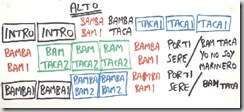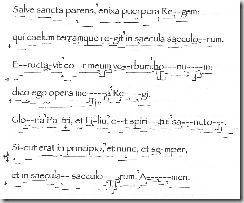[this is a version of a post which first appeared on my blog From the Front of the Choir]
The choirs and workshops that I lead are run on the principle that music should be accessible to all. This means that I don’t use written music to teach since I can’t assume that everyone can read music.

But is there a limit to the complexity of a song that can be taught without using a written score?
The kind of material that I use most often comes from cultures and traditions where songs are passed down from generation to generation through the oral/ aural tradition. Such songs are often quite short and fairly repetitive without many words, so lend themselves to being taught by ear. These songs are particularly suitable for short workshops as they are quite easy to learn and I can offer a range of styles in a short time.
However, in a choir which meets regularly, singing such ‘easy’ short songs soon becomes unsatisfying so we like to add something more challenging to our singing diet.
One obvious development is to use songs which have several verses which we can then build up in performance by introducing harmonies as the song progresses, thus adding interest for an audience.
We can also tackle longer pieces that are basically several shorter songs tacked together, different ‘movements’ if you like. Many South African songs fit into this category (e.g. Nkosi sikelel'i Afrika, Ladysmith Black Mambazo's version of Amazing Grace, Akanamandla).
You don’t have to learn the whole song at once. We can learn a new part each term and gradually extend the song as time goes by. We’ve also tackled longer church songs from Eastern Europe. In these, the melody lines go through a few subtle changes as the song progresses, but the individual units of melody are quite easy to learn and the overall effect is to add interest and texture to a song.
But then we come to more complex (usually modern) arrangements of songs, or songs which are fairly intricate and yet each section is frustratingly similar to the others so is very hard to learn.
Recently I tried to teach Samuel Barber’s vocal version of his famous Adagio for Strings (Agnus Dei), but had to give up because there were so many long sustained notes and no easy way of knowing how long they should each be held.
Then with a big choir I wanted to teach Ysaye Barnwell’s Lawd it’s midnight. I had originally been taught this using the written score, but the timing is complicated and I am convinced it would be much easier to teach the timing by ear and by allowing the rhythm into the body. The trouble is, the melody and parts are too complex to do in this way! (Interestingly, Ysaye Barnwell has taught Handel’s Messiah by ear. It takes longer, but is not impossible)
I decided to teach a four-part arrangement of the Mexican song La Bamba. It is a fairly straightforward arrangement in that it follows the well-known tune and there are no weird chords, but there are lots of backing parts with short riffs that are repeated, then a short filler phrase, then the riff repeated again but with minor variations.
It is very easy to lose track of how many times you’ve sung a particular riff, and exactly when you have to put the little filler parts in. We managed to learn the song, but it took a long time and was easily forgotten if we didn’t revise it regularly.
I did get to the point where I wondered if it was worth persisting teaching it by ear or was there another (better?) way? Could I find a more effective way of teaching it by ear? Could I use something visual to help the singers know where they were?
One way to tackle complex songs would be to record all the parts on a CD and give it out to the singers to learn at home. But this removes the fun and community spirit of learning together in our weekly sessions. Also, some complex songs would still be hard to learn like this by just listening, even if singers can hear the other parts at the same time. I don’t want to end up in concert with singers counting on their fingers to know how many times to sing a particular riff!
In many cases it seems it would help to have some kind of map to help the singers learn the overall structure of the song.
“Why not simply give them the music?”, you ask. Well, I suppose I could. Even if people can’t read music very well, they could at least use the scores to see where their part changes and how many times bits are repeated.
I’m reluctant to do this for several reasons. One is that it’s a slippery slope and there may be a demand to have the music for all the songs we sing (I know some individuals would be much more comfortable if this were the case!). This somehow goes against the spirit of the choir and the fun learning experience we have each session.
But perhaps more worryingly, having given out the music which represents a complex song, how can I persuade people to put it down when it comes to performance? It’s hard enough getting people to learn the words to songs!
I did a weekend workshop with Northern Harmony some years ago. For some of the Georgian and Corsican songs in their repertoire, rather than produce a complete written score, they used a schematic technique to show a map of the melody lines of each part:

This was fairly easy to follow once a line had been sung to us a few times.
(Strangely enough this is exactly the kind of notation that many bass parts in my choirs invent independently. It’s usually the bass part because they don’t often have an easily recognisable tune. When I point out that this is a music notation, they usually deny it, somehow believing that written music must be something far more difficult and clever!)
This method is very effective for mapping out melody lines, especially when they vary just slightly throughout a piece, but not very useful when we're dealing with the overall structure of a complex song.
I took this idea and created a ‘musical map’ to teach La Bamba (see image at the top of this post). I was rather wary when I first unveiled my attempt, but most people seemed to find it useful. We did seem to go faster after I started using the wall charts. Trouble is there are so many of them and it takes ages to put them up on the wall!
So far I have used different shapes and colours to help guide people through complex structures. In the meantime, if anyone else has any ideas ... !
My question to you is: what is the limit in complexity that can be taught by ear? Can we teach anything by ear given enough time? If we need to resort to some kind of map or written score, how do we then get it out of people’s hands for performances?
Chris Rowbury: chrisrowbury.com